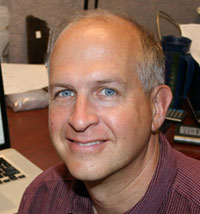Cosmic Chemistry

Andrew Westphal is gathering dust. Not because he’s sitting around without much to do. On the contrary, Dr. Westphal, Associate Director of UC Berkeley’s Space Sciences Laboratory, is the author of over 200 scientific papers and an active researcher in the scientific field known as cosmochemistry. The dust that interests Dr. Westphal is not the ordinary household type, which is composed of fabric fibers, insect parts, flakes of dead skin, and other detritus. Dr. Westphal’s dust is much more exotic and much rarer. It’s stardust.
As one of the senior members of the team behind NASA’s Stardust mission, Dr. Westphal helped design and build a spacecraft to journey to a comet. The plan was to return to Earth samples of material from the comet and stardust that may have come from outside our Solar System. This kind of dust is essentially tiny grains of rock, as well as associated organic and volatile materials and ices. Dust is thought to be key in enriching forming solar systems with the material to build rocky planets. In our own Solar System, this heavy element enrichment also provided the materials for life to arise.
In this research profile we will explore these key questions:
- How can scientists obtain samples of the primitive material from which our Solar System formed?
- Why do scientists need help from the public to understand their data?
- Why does understanding the formation of the Earth and the conditions for life require spacecraft, computers, and microscopes?
- How has the Stardust mission changed our understanding of conditions in the early Solar System?
